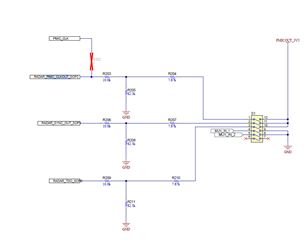Tool/software:
Hello,
I have a question about the resistors connected to SOP terminal of IWR6843ISK.
Why are three resistors connected to each SOP terminal?
Could you please explain the purpose of each resistor?
Regards,
Kei

This thread has been locked.
If you have a related question, please click the "Ask a related question" button in the top right corner. The newly created question will be automatically linked to this question.
Tool/software:
Hello,
I have a question about the resistors connected to SOP terminal of IWR6843ISK.
Why are three resistors connected to each SOP terminal?
Could you please explain the purpose of each resistor?
Regards,
Kei

Hello there,
The device SOP pins cannot be at floating state as well as be directly connected to power lines for they are pinmuxed with several signals. That is why a PUPD network (with default pull down) has been deployed.
Now let's consider two conditions where the switch turns any of the SOP signals to 1) Logic low (GND) and 2) Logic High (VIOIN)
1) If the switch turns the signal to logic low (GND), 7.87k and 82.5k comes in parallel, which in series with 10k gives a strong pull down of ~17kOhms.
2) If the switch turns the signal to logic high, as per standard pull up, the voltage divider gives a ~1:10 ratio and (with no effect of the series 10k) SOP signal goes to logic high.
I hope that solves your query.
Thanks
Swarnendu
Hi, Swarnendu,
Thank you for your reply. I understand the purpose, but why is a series 10kohm necessary?
Is 7.18kohm(7.87kohm // 82.5kohm) insufficient, and is 17kohm necessary?
Regards,
Kei
Hi,
As I told before, SOP pins are pinmuxed with several other signals for example TDO of JTAG with SOP0, PMIC clock out with SOP1. The series 10k resistor is placed to isolate the strong pull up or pull down to affect the drive strength of those signals.
Thanks
Swarnendu